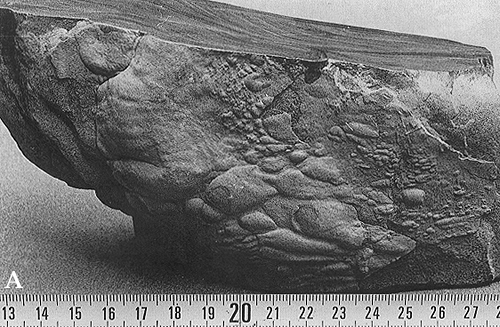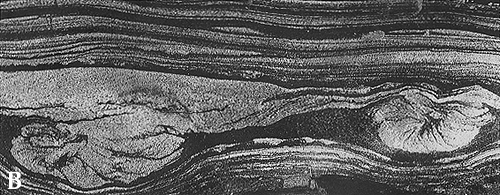

"Squamiform" load casts (A) and load-casted ripples (B)
Plate 125


"Squamiform" load casts (A) and load-casted ripples (B)
Plate 125
Load structures can assume these curious aspects at the base of thin, cross-laminated beds. The term "squamiform load casts" was invented in the Fifties, when most sole marks of turbidites were defined and classified. Structures like these had caught the eye of geologists years before, and received more fanciful names, like "dinosaur leather." 2 In this imaginative inclination, one could also say that they resemble the marks of paws.
The elongation of the load structures in the current direction, as can be checked by foreset laminae visible in section (A), seems to indicate that, also in this case, current marks were present on the bed surface before loading. It is possible that partial liquefaction of fine sand laminae contributed to the deformation.
In plate 125 B, brainlike sand pockets, thicker than the feeding bed, apparently grew by stacking of successive smaller lobes. The lobes were somewhat stuffed into the mud, with a component of lateral rotation. The interpretation is that the load was combined with current drag in forming these pockets as outgrowths of a pinch-and-swell structure (compare with plate 94). The troughs of ripples would have sunk more than usual and in successive stages, whence the term load-casted ripples. Barely visible foreset laminae indicate the paleocurrent direction.
A: Marnoso-arenacea Formation, northern Apennines. B: Kliwa Sandstone, Polish Carpathians.
Note 2: G. H. Chadwick. 1943. Ordovician "dinosaur leather" marking (exhibit). Bull. Geol. Soc. Amer. 59: 1315. Back.